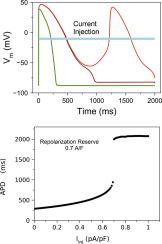Journal of Molecular and Cellular Cardiology ( IF 4.9 ) Pub Date : 2020-04-20 , DOI: 10.1016/j.yjmcc.2020.04.019 Namit Gaur 1 , Francis Ortega 2 , Arie O Verkerk 3 , Isabella Mengarelli 4 , Trine Krogh-Madsen 2 , David J Christini 2 , Ruben Coronel 5 , Edward J Vigmond 1

|
Repolarization reserve, the robustness of a cell to repolarize even when one of the repolarization mechanisms is failing, has been described qualitatively in terms of ionic currents, but has not been quantified by a generic metric that is applicable to drug screening. Prolonged repolarization leading to repolarization failure is highly arrhythmogenic. It may lead to ventricular tachycardia caused by triggered activity from early afterdepolarizations (EADs), or it may promote the occurrence of unidirectional conduction block and reentry. Both types of arrhythmia may deteriorate into ventricular fibrillation (VF) and death. We define the Repolarization Reserve Current (RRC) as the minimum constant current necessary to prevent normal repolarization of a cell. After developing and testing RRC for nine computational ionic models of various species, we applied it experimentally to atrial and ventricular human induced pluripotent stem cell-derived cardiomyocyte (hiPSC-CM), and isolated guinea-pig ventricular cardiomyocytes. In simulations, repolarization was all-or-none with a precise, model-dependent critical RRC, resulting in a discrete shift in the Action Potential Duration (APD) - RRC relation, in the occurrence of EADs and repolarization failure. These data were faithfully reproduced in cellular experiments.
RRC allows simple, fast, unambiguous quantification of the arrhythmogenic propensity in cardiac cells of various origins and species without the need of prior knowledge of underlying currents and is suitable for high throughput applications, and personalized medicine applications.
中文翻译:

复极储备的定量测量作为药物诱导的心律失常的新标志物的验证。
复极储备,即细胞在复极机制之一失效时复极的稳健性,已根据离子电流进行定性描述,但尚未通过适用于药物筛选的通用指标进行量化。导致复极失败的长期复极是高度心律失常的。它可能导致由早期后去极化(EADs)触发的活动引起的室性心动过速,或者可能促进单向传导阻滞和折返的发生。两种类型的心律失常都可能恶化为心室颤动 (VF) 和死亡。我们将复极储备电流 (RRC) 定义为防止细胞正常复极所需的最小恒定电流。在为各种物种的九种计算离子模型开发和测试 RRC 之后,我们通过实验将其应用于心房和心室人诱导多能干细胞衍生心肌细胞 (hiPSC-CM) 和分离的豚鼠心室心肌细胞。在模拟中,复极是全有或全无,具有精确的、依赖于模型的临界 RRC,导致动作电位持续时间 (APD) - RRC 关系的离散变化,在发生 EAD 和复极失败时。这些数据在细胞实验中得到了忠实再现。在EADs和复极失败的发生。这些数据在细胞实验中得到了忠实再现。在EADs和复极失败的发生。这些数据在细胞实验中得到了忠实再现。
RRC 允许简单、快速、明确地量化各种来源和物种的心脏细胞的致心律失常倾向,而无需了解潜在电流的先验知识,并且适用于高通量应用和个性化医疗应用。










































 京公网安备 11010802027423号
京公网安备 11010802027423号